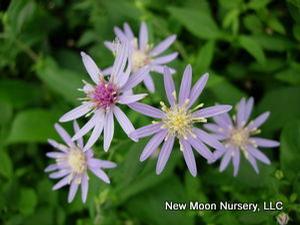New Moon Nurseries

A great naturalizer for shaded areas, blue wood aster brightens up shady spots and attracts pollinators.
Aster cordifolius
Blue wood aster
Native to North America
FIRST IMPRESSIONS: Aster cordifolius is an upright perennial. Heart shaped leaves occur at ground level and form a nice groundcover in spring. In early to mid-fall small daisy-like asters cover the plant. Flowers are blue with yellow centers and are attractive to bees, skippers and butterflies. Plants are tough and adaptable prospering in sun or shade and in difficult disturbed sites.
HABITAT & HARDINESS: The range of Aster cordifolius extends from Canada south to the Florida Panhandle and west to Oklahoma.
Indigenous plants occur in open woods, clearings, along creek banks and deciduous woodland edges. This aster is also found in disturbed urban sites, thickets, roadsides and ditches.
Plants are hardy from USDA Zones 3-10.
PLANT DESCRIPTION: Aster cordifolius is an erect warm season perennial that branches occasionally in the plant’s upper half. Individuals form small colonies from underground rhizomes and have a tendency to self-seed as well.
Lower leaves are up to 5” long and heart shaped with coarse teeth. Upper leaves are smaller with an ovate shape.
Branched flower panicles appear in late summer and bloom continues until mid-fall. The individual flower heads are composed of a ring of blueish petal-like ray flowers surrounding a central cluster of yellow disc flowers. The heads are produced in profusion but are only ½” in diameter.
Plants grow 2-3’ tall with 2-3’ spread.
CULTURAL & MAINTENANCE NEEDS: The great advantage that Aster cordifolius offers is the ability to grow and flower in sun or shade. Flowering and form are best with 3 hours or so of sun. In dense shade stems may arch or bend so that pruning may be needed.
Plants tolerate average, dry or moist soil. They self seed to the point that some describe the plant as “weedy”. This should not be an issue in a natural setting but in smaller more manicured gardens, spent flowers can be removed to prevent seed formation.
Aster cordifolius is drought tolerant and somewhat unpalatable to deer and rabbits.
LANDSCAPE USES: This is a good choice for a Wildlife Garden or Shade Garden. Plants are also used as Butterfly Nectar Plants, Butterfly Host Plants or as part of a Grouping or Mass Planting. Aster cordifolius has Showy Blooms and can be used in Cottage Gardens, Deer Resistant Plantings, Water-wise Landscapes, Low Maintenance Plantings, Dry Meadows, Perennial Borders, Roadsides and Restoration Projects.
COMPANION & UNDERSTUDY PLANTS: At woods edge try pairing Aster cordifolius with Eupatorium colestinum, Heliopsis helianthoides and Amsonia hubrichtii.
Aster divaricatus has similar height and habitat needs and can be substituted if needed.
TRIVIA: Many of the established Latin names of Aster spp. were changed recently due to DNA and genetic research findings. So Aster cordifolius is now known as Symphyotrichum cordifolium.
This species is very similar to Aster divaricatus. Cultural differences between the two include the fact that Aster cordifolius blooms a little later, is more upright and a little taller. Aster cordifolius has bluish flowers that are smaller but usually produced in greater numbers.
Plants host caterpillars of the Silvery Checkerspot Butterfly, Pearl Crescent Butterfly and several species of moths.
Height:
2-3 FeetSpread:
2-3 ftSpacing:
2-3 ftUSDA Hardiness Zone:
3-10Bloom Color:
Lavender-BlueAster cordifolius Characteristics
Attracts Wildlife
- Butterflies
- Pollinators
Attributes
- Naturalizing
- East-Coast Native
- Drought Tolerant
- Cut Flower
- Clay Soil
Exposure
- Full Shade to Partial Shade
Flowering Months
- November
- October
- September
- August
Foliage Color
- Green
Juglans nigra Tolerance (Black Walnut)
- Yes
Salt Tolerance
- Medium
Season of Interest (Foliage)
- Summer
- Spring
Soil Moisture Preference
- Moist to Dry
Interesting Notes:
AKA Symphyotrichum cordifoilius
For more information on this plant, visit the USDA PLANTS Database: http://plants.usda.gov/java/profile?symbol=SYCO4